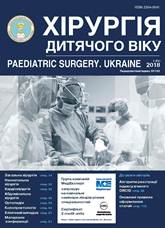Screening monitoring of early prophylaxis of the orthopedic complications in children after acute haematogenous osteomyelitis
DOI:
https://doi.org/10.15574/PS.2018.59.59Keywords:
ultrasound densitometry, orthopaedic complications, acute haematogenous osteomyelitisAbstract
Objective: to establish screening observation over the children after acute haematogenous osteomyelitis (AHO) with the purpose of an early detection and prevention of orthopaedic complications development.Material and methods. A total of 135 children with AHO aged from birth to 18 years, who were treated in 2003–2017, were examined in Lviv. The control group comprised 53 (39.2%) patients without the orthopaedic complications after AHO. The main (reference) group included 82 (60.7%) children with the developed orthopaedic complications of AHO.
Results. Analysis of densitometric values showed that after the termination of the inflammatory process, there were signs of bone density dysfunction in all patients. In 56.25±7.16% of children, the violations of bone arterectonics and delay of the enchondral ossification from the passport age for 3–5 years were revealed; the signs of severe osteopenia were detected in 35.42±6.90 % of patients, and the signs of osteoporosis – in 10.42±4.41%. Frequent violations in the mineral metabolism in patients of all the examined groups after AHO were the tendency to hypocalcaemia and hypercalciuria. The increase of parathyroid hormone concentration in patients after AHO indicates early loss of bone mass.
Conclusions. During the period from 3 to 12 months after AHO, the dynamic densitometric monitoring is needed to detect the degree of bone tissue changes and timely treatment of osteopenia and osteoporosis, which are the predictors of the orthopaedic complications development in children.
References
Moiseienko RO. (2009). Chastota i struktura zakhvoriuvanosti ditei v Ukraini ta shliakhy yii znyzhennia. Sovremennaya pediatriya. 2(24): 10-15.
Povorozniuk VV, Vilenskyi AB, Hryhorieva NV. (2001). Osteopenichnyi syndrom u ditei ta pidlitkiv: faktory ryzyku, diahnostyka, profilaktyka. Metodychnyi posibnyk. Kyiv: 27.
Frolova TV. (2006). Otsinka strukturno-funktsionalnoho stanu kistkovoi tkanyny ditei ta pidlitkiv za rezultatamy ultrazvukovoi densytometrii. Metodychni rekomendatsii MOZ ta AMN Ukrainy. Kharkiv: 16.
Scheplyagina LA et al. (2007). Osteoporoz u detey: problemyi i resheniya. Rossiyskiy pediatricheskiy zhurnal. 2: 4-8.
Delmas PD, Eastell R, Garnero P et al. (2012). The use of biochemical markers of bone turnover in osteoporosis. Osteoporosis Int. 11(6): 2–17.
Lebedevych OB. (2011). Analysis of densitometric indices in predicting the development of orthopedic complications of acute hematogenous osteomyelitis. Practical medicine. 17; 4: 126-128.
Downloads
Issue
Section
License
The policy of the Journal “PAEDIATRIC SURGERY. UKRAINE” is compatible with the vast majority of funders' of open access and self-archiving policies. The journal provides immediate open access route being convinced that everyone – not only scientists - can benefit from research results, and publishes articles exclusively under open access distribution, with a Creative Commons Attribution-Noncommercial 4.0 international license(СС BY-NC).
Authors transfer the copyright to the Journal “PAEDIATRIC SURGERY.UKRAINE” when the manuscript is accepted for publication. Authors declare that this manuscript has not been published nor is under simultaneous consideration for publication elsewhere. After publication, the articles become freely available on-line to the public.
Readers have the right to use, distribute, and reproduce articles in any medium, provided the articles and the journal are properly cited.
The use of published materials for commercial purposes is strongly prohibited.

